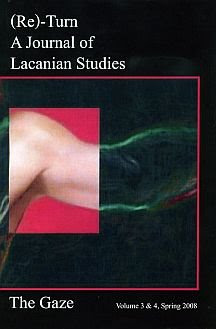Volume 3 and 4 of
(Re)-Turn: A Journal of Lacanian Studies
is released.
Further information on the journal (including subscription instruction) is available on their website: http://return.jls.missouri.edu/Lacan/
ABOUT RETURN
Edited by Ellie Ragland and Evelyn Moore in consultation with Jacques-Alain Miller, (Re)-turn: A Journal of Lacanian Studies explores the theories of French psychoanalyst, Jacques Lacan, within the context of a variety of fields, including clinical psychoanalysis, philosophy, critical studies, theatre, politics, music, visual arts, mass media, communications, religion, and literature.
The name of the journal—(Re)-turn: Journal of Lacanian Studies—signifies a number of things, Lacan’s return to Freud, the transformations in Lacan’s own work, as well as the return to the first American Lacanian journal, Newsletter of the Freudian Field (1987-1994). For Lacan, return has been a particularly important term, a psychoanalytic concept based on the premise that every juncture, every point of understanding or knowledge, is not only present in conscious life, but is represented precisely as a return where the conscious intersects with the unconscious. This is the place around which Lacanian studies must revolve.
Table of Contents
Editorial
Edited by Ellie Ragland and Evelyn Moore in consultation with Jacques-Alain Miller, (Re)-turn: A Journal of Lacanian Studies explores the theories of French psychoanalyst, Jacques Lacan, within the context of a variety of fields, including clinical psychoanalysis, philosophy, critical studies, theatre, politics, music, visual arts, mass media, communications, religion, and literature.
The name of the journal—(Re)-turn: Journal of Lacanian Studies—signifies a number of things, Lacan’s return to Freud, the transformations in Lacan’s own work, as well as the return to the first American Lacanian journal, Newsletter of the Freudian Field (1987-1994). For Lacan, return has been a particularly important term, a psychoanalytic concept based on the premise that every juncture, every point of understanding or knowledge, is not only present in conscious life, but is represented precisely as a return where the conscious intersects with the unconscious. This is the place around which Lacanian studies must revolve.
Table of Contents
Editorial
Volume 3: The Gaze: Fantasy and the Desire of the Other
Jacques Alain Miller: Chapter II – Fantasy and the Desire of the Other
Evelyn K. Moore: The Deadly Gaze: Penthesilea and Achilles in Love
Mary Jane Cowles: The Gaze: The Fold in Balzakc’s Lys dans la Vallee
Clifford T, Manlove: On the « Split » between the Eye and the Gaze in Literature
Volume 4: The Topology of the Gaze
Ellie Ragland: The Topological Dimension of Lacanian Optics
Gerard Wajcman: On Painting
Jeanne Lafont: The inherent twisting of the Gaze
Efrat Biberman: Of the Gaze as topological Locus
Jennifer Friedlander: Affecting Art: Barthes, Kertesz, and Lacan







